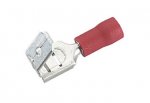Boater Sam
Well-Known Member
Twaddle. The world used to run on soldered joints till the nay sayers started making money out of selling fancy connectors.The industry would seem to disagree. Solder joints apparently don't do well where there is potential for movement such as on boats, and can cause broken wires or strands*. I can't see it being a huge issue if done well, but taken at scale these things generally are not done well. I used Wago connectors for the first time this year and was pleasantly surprised how good and cheap they were (they are genuine, but still inexpensive). The main issues with them are needing the space and needing the correct size. I absolutely hate standard insulated crimp connectors, even with good tools they fail to crimp tightly too often. Other crimps are fine though, and these days I prefer a nicely specced connector with crimped pins for most jobs, the downside to which is I now have 6 crimp tools and a locker full of various connectors ?
*someone like Paul will hopefully be along with the real explanation shortly
The USA runs on twisted wires and screwits.


